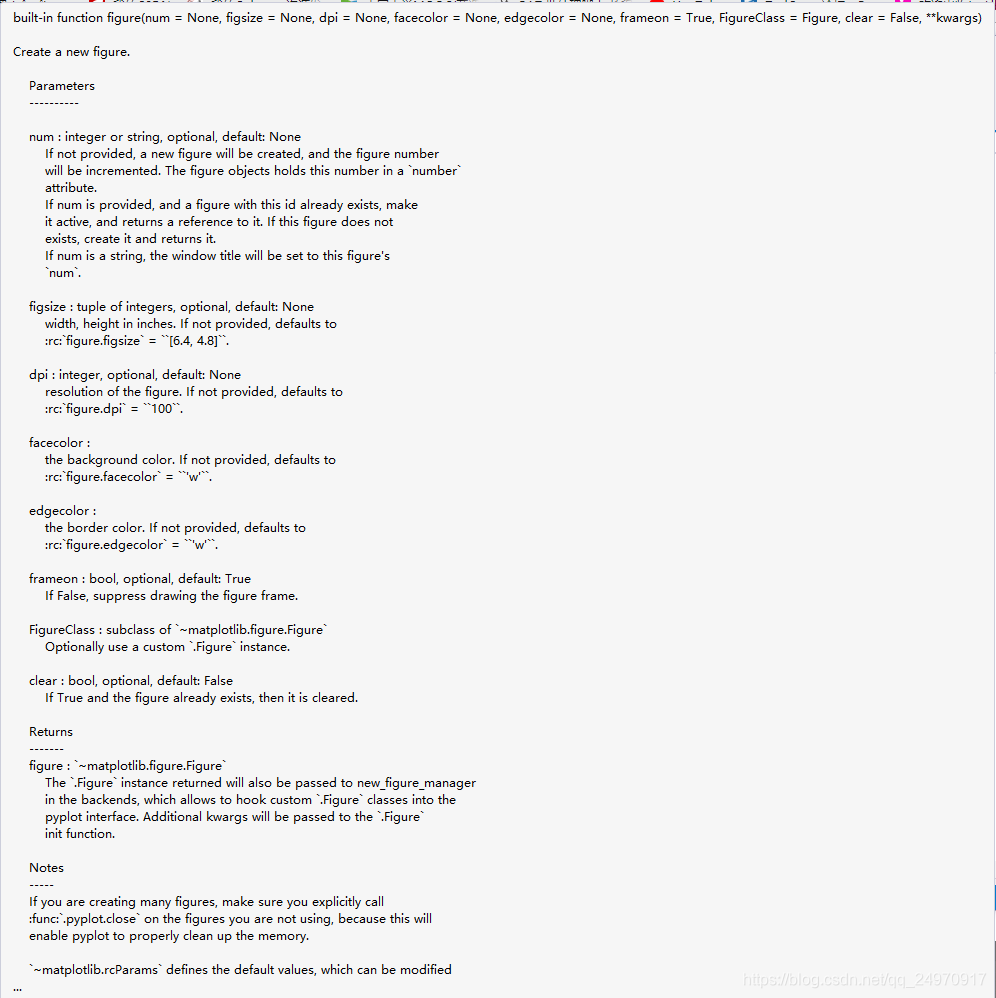Matplotlib python作图
导入需要的包numpy和matpl
import numpy as np
import matplotlib.pyplot as plt
作图实例
x=np.arange(1,10) #x=array([1, 2, 3, 4, 5, 6, 7, 8, 9])
y=3*x+5 #y=array([ 8, 11, 14, 17, 20, 23, 26, 29, 32])
plt.plot(x,y) #[<matplotlib.lines.Line2D object at 0x000001E4B9CB3AC8>]
plt.show()

作[−π,π][-\pi,\pi][−π,π]上y=sinx的图
x=np.arange(-np.pi,np.pi+0.01,0.01)
y=np.sin(x)
plt.plot(x,y)
plt.show()
![y=sinx,x∈[-\pi,\pi]](https://i-blog.csdnimg.cn/blog_migrate/a5396d94169e2a6985c4f14a95fab9c5.png)
plt.title(" ") #改变标题
plt.xlabel(" " #改变x轴名称
plt.ylabel(" ") #改变y轴名称
在plt.plot()中添加不同的格式字符能达到不同的显示效果
| 字符 | 效果 |
|---|---|
| “-” | 实线 |
| “–” | 虚线 |
| “-.” | 点划线 |
| “g” | 绿色 |
| “r” | 红色 |
| … | … |
#颜色用plt.plot(color=" ")
#虚线或实现用plt.plot(linestyle=" ")
#要在同一张图中作两张子图,需要plt.subplot()
import numpy as np
import matplotlib.pyplot as plt
x=np.arange(-3*np.pi,3*np.pi,0.1)
y1=np.cos(x)
y2=np.sin(x)
plt.subplot(2,2,1) #高为2,宽为1,第1张图
plt.plot(x,y1)
plt.subplot(2,2,2) #高为2,宽为1,第2张图
plt.plot(x,y2)
plt.show()

#同时作出两张图,需要在代码中添加 plt.figure()
x=np.arange(1,10)
y1=3*x
y2=np.sin(x)
plt.figure()
plt.plot(x,y1)
plt.figure()
plt.plot(x,y2)
plt.show()
#plt.figure(" ")中可填入figure名称
#figure(figsize=(a,b))可调整大小

设置坐标轴
plt.xlim((left,right)) #给出范围
plt.xlim(left=3) #只给出左边的界限
plt.xlim(right=10) #只给出右边的界限
柱状图
plt.bar(x,y)
3D图
import numpy as np
import matplotlib.pyplot as plt
from mpl_toolkits.mplot3d import Axes3D
fig=plt.figure()
ax=Axes3D(fig)
X=np.arange(-4,4,0.25)
Y=np.arange(-4,4,0.25)
X,Y=np.meshgrid(X,Y) #将两个一维数组变成二维数组
>>> X
array([[-4. , -3.95, -3.9 , ..., 3.85, 3.9 , 3.95],
[-4. , -3.95, -3.9 , ..., 3.85, 3.9 , 3.95],
[-4. , -3.95, -3.9 , ..., 3.85, 3.9 , 3.95],
...,
[-4. , -3.95, -3.9 , ..., 3.85, 3.9 , 3.95],
[-4. , -3.95, -3.9 , ..., 3.85, 3.9 , 3.95],
[-4. , -3.95, -3.9 , ..., 3.85, 3.9 , 3.95]])
>>> Y
array([[-4. , -4. , -4. , ..., -4. , -4. , -4. ],
[-3.95, -3.95, -3.95, ..., -3.95, -3.95, -3.95],
[-3.9 , -3.9 , -3.9 , ..., -3.9 , -3.9 , -3.9 ],
...,
[ 3.85, 3.85, 3.85, ..., 3.85, 3.85, 3.85],
[ 3.9 , 3.9 , 3.9 , ..., 3.9 , 3.9 , 3.9 ],
[ 3.95, 3.95, 3.95, ..., 3.95, 3.95, 3.95]])
R=np.sqrt(X*X+Y*Y)
Z=np.sin(R)
ax.plot_surface(X,Y,Z,cmap=plt.get_cmap('rainbow'))
plt.show()







 本文详细介绍了使用Python的Matplotlib库进行数据可视化的方法,包括基本的线性图表绘制、正弦曲线、余弦曲线的子图展示,以及如何调整图表样式、颜色和线条类型。此外,还讲解了如何创建3D表面图,并提供了调整坐标轴范围和制作柱状图的技巧。
本文详细介绍了使用Python的Matplotlib库进行数据可视化的方法,包括基本的线性图表绘制、正弦曲线、余弦曲线的子图展示,以及如何调整图表样式、颜色和线条类型。此外,还讲解了如何创建3D表面图,并提供了调整坐标轴范围和制作柱状图的技巧。
















 1万+
1万+

 被折叠的 条评论
为什么被折叠?
被折叠的 条评论
为什么被折叠?








